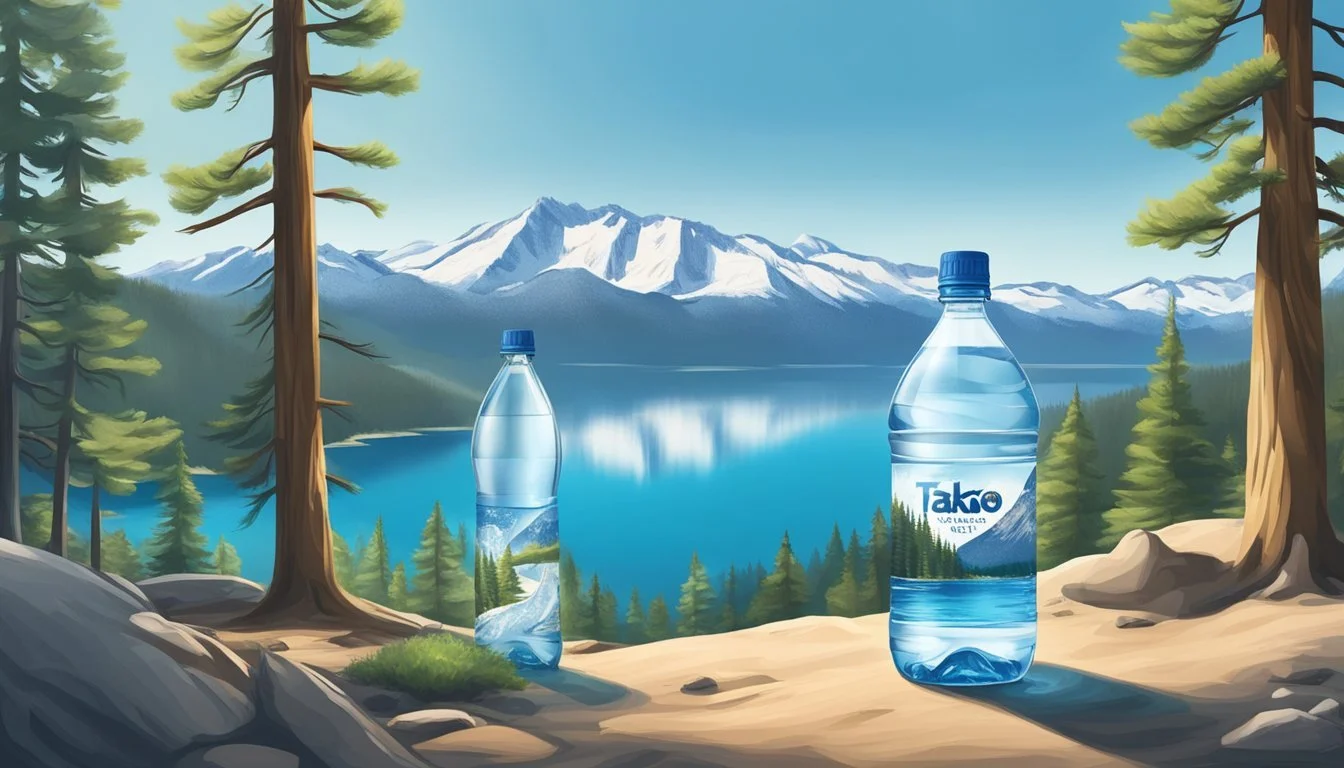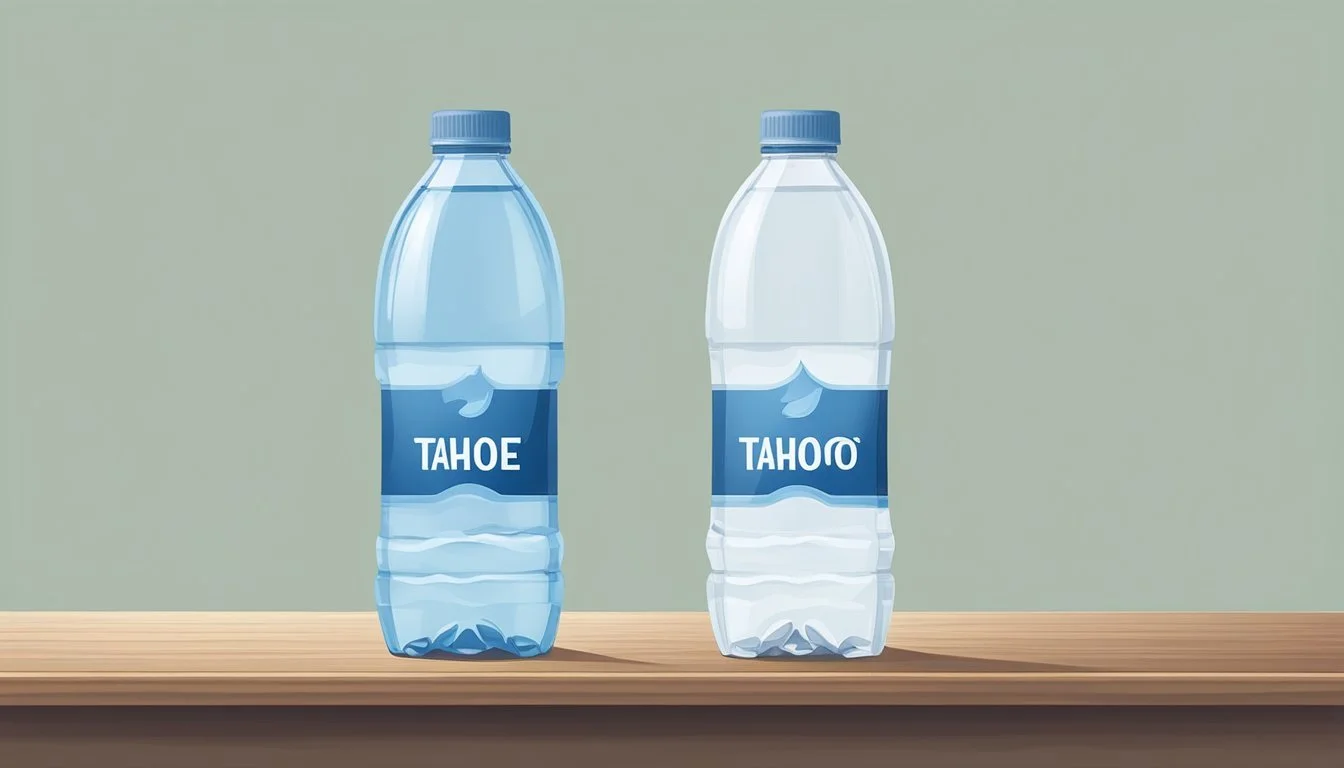Tahoe vs. Action
Analyzing the Superior Bottled Water
When it comes to choosing the right bottled water, consumers often find themselves comparing brands to determine the best option for their hydration needs. In this article, the focus is on evaluating Tahoe and Action, two popular bottled water brands, to see how they stack up against each other. Tahoe bottled water stands out due to its refreshing taste and quality sourced from pristine natural springs.
On the other hand, Action bottled water emphasizes its rigorous filtration process and eco-friendly packaging, making it a strong contender for environmentally conscious consumers. Both brands have their unique selling points, whether it's the high-quality source of water that Tahoe prides itself on or the sustainable practices followed by Action.
In the quest for the best bottled water, it's essential to consider what matters most to you, whether it's taste, source, or environmental impact. By comparing these factors directly, the goal is to help you make an informed choice between Tahoe and Action, ensuring you select the bottled water that meets your preferences and needs.
Comparing Water Sources
When comparing Tahoe and Action bottled water, understanding the origins and purification methods is crucial. Tahoe primarily sources its water from natural springs, whereas Action relies mostly on purified groundwater. Each method offers unique benefits related to purity and taste.
Natural Sources and Their Purity
Tahoe water originates from high-altitude natural springs known for their exceptional purity. These springs, located in pristine environments, are regularly tested to ensure the absence of contaminants.
The minerals found in natural springs give Tahoe water a distinctive taste and essential nutrients.
Natural springs and aquifers contribute significantly to the taste and health benefits of spring water. This makes Tahoe a preferred choice for consumers seeking naturally sourced hydration.
Processed Waters: Purification and Reverse Osmosis
Action bottled water, on the other hand, undergoes extensive purification processes, including reverse osmosis. This technique filters impurities and contaminants, providing high purity levels.
Action's water is typically harvested from groundwater sources, which might contain various dissolved solids. The purification process removes these, ensuring safe drinking water.
Reverse osmosis also eliminates any potential pathogens, making it a reliable choice for those prioritizing safety and purity. This processing method enables Action to offer consistent quality, regardless of the initial water source.
Analyzing Water Quality Parameters
When comparing Tahoe and Action bottled water brands, it is essential to understand their water quality parameters, including pH levels, mineral content, safety standards, and contaminant testing. These factors significantly influence both taste and safety.
PH Levels and Mineral Content
pH Levels:
The pH level of water directly impacts its taste and corrosiveness. Tahoe water generally maintains a neutral pH, often close to 7, ensuring it is neither acidic nor basic. Action water similarly aims for a balanced pH, but slight variations can occur based on the source.
Mineral Content:
Tahoe water showcases a balanced profile with moderate potassium and low sodium, catering to those seeking hydration without excessive minerals. In contrast, Action water also strives for a balanced mineral content but may have different levels of calcium and magnesium. Both brands pride themselves on their natural mineral compositions, sourced meticulously to ensure quality.
Safety Standards and Contaminant Testing
Safety Standards:
Both Tahoe and Action adhere to strict safety standards set by the EPA. These standards ensure that bottled water meets or exceeds safety guidelines, including limits on contaminants.
Contaminant Testing:
Regular contaminant testing is crucial. Tahoe water undergoes rigorous tests for contaminants like lead, ensuring levels are within safe limits. Action water also follows stringent testing protocols to detect and eliminate harmful bacteria, viruses, and other potential threats. Both brands prioritize transparency, providing water quality reports to assure consumers of their commitment to safety.
The combined focus on pH balance, mineral content, and stringent safety measures highlights the dedication of both Tahoe and Action to offering clean, safe drinking water.
Health and Hydration Benefits
Tahoe and Action bottled waters offer various health benefits including essential minerals and effective hydration capabilities, each appealing to different health considerations and preferences.
Essential Minerals and Electrolytes
Tahoe water is renowned for its pristine purity, containing naturally occurring minerals such as calcium and magnesium. These minerals are crucial for bone health and muscle function.
Calcium aids in maintaining the structural integrity of bones and teeth, while magnesium helps with muscle relaxation and nerve function. Tahoe's mineral-rich composition supports overall physical well-being by replenishing essential electrolytes lost during physical activities.
Action water, on the other hand, is often purified and might lack these natural minerals. Its main strength lies in its clean and crisp taste, which it achieves through a rigorous purification process. For those who prioritize purity and taste over mineral content, Action offers a safe option free from contaminants.
Hydration and Health Impact
Proper hydration is fundamental for sustaining optimal health. Tahoe and Action ensure safe drinking water, contributing significantly to daily hydration needs. Tahoe's mineral content not only aids in hydration but also enhances the water’s taste, making it more appealing and encouraging consistent consumption.
Action water, with its refined purity, provides excellent hydration capabilities. It quenches thirst effectively, making it ideal for people who prioritize a neutral and refreshing taste. For those who are physically active or require increased hydration, both Tahoe and Action waters serve as reliable sources to help maintain necessary hydration levels.
Considering health and hydration, the choice between Tahoe and Action may come down to personal priorities between mineral intake and purified taste.
Flavor Profile and Packaging
This section compares Tahoe and Action bottled waters focusing on their taste and packaging options. The distinct flavor profiles and the choice between plastic and glass packaging are considered.
Assessing Taste: Tahoe vs Action
Tahoe bottled water is recognized for its neutral, minimal flavor, appealing to those who prefer a simple and unobtrusive taste. This makes it a suitable choice for hydration without any noticeable aftertaste.
In contrast, Action water offers a crisp and clean flavor profile. Some may find it slightly more refreshing due to its purification process, which removes impurities and provides a more pristine taste. Both brands appeal to different taste preferences, making the choice dependent on individual flavor inclinations.
Packaging Choices: Plastic vs Glass
Tahoe often utilizes plastic bottles, which are lightweight and convenient for on-the-go use. Plastic bottles are commonly BPA-free, ensuring safety from harmful chemicals like bisphenol A and S.
Action typically uses glass bottles, adding a premium feel and enhancing the water's purity by avoiding potential plastic contamination. Glass bottles are more eco-friendly, as they are easily recyclable and do not leach chemicals.
The choice between plastic and glass impacts both the user experience and environmental footprint. While plastic offers practicality, glass provides a sustainable and high-quality alternative. Both packaging options cater to different consumer needs and preferences.
Environmental Impact and Sustainability
When comparing Tahoe and Acqua Panna, it's crucial to examine their environmental impacts and sustainability practices. The production and consumption of bottled water have significant implications for the environment, but some brands are striving to mitigate these effects.
Bottled Water and the Environment
Bottled water production releases considerable CO2 emissions. For example, producing 50 oz of bottled water can release between 1.6 and 22 oz of CO2.
Using Barcelona as a case study, the environmental cost of everyone consuming bottled water would be an additional $83.9 million annually. Notably, bottled water is 3,500 times worse for the environment than tap water, highlighting its substantial carbon footprint.
Sustainability Practices in Water Brands
Tahoe and Acqua Panna both recognize the importance of sustainability. Tahoe water, sourced from the Tahoe Basin, emphasizes low sodium levels and moderate potassium content, reflecting a commitment to maintaining water quality.
Acqua Panna has incorporated recycled plastic into their bottles, reducing waste and promoting environmental responsibility. Both brands are making efforts to minimize their environmental impact through sustainable sourcing and packaging practices.
Acqua Panna uses 100% recycled plastic for their bottles, demonstrating a commitment to environmental preservation. Tahoe's approach includes ensuring pure water from natural sources, focusing on sustainability and minimal environmental disruption.
Cost and Accessibility
When evaluating Tahoe and Action bottled water, it's important to consider both cost and consumer accessibility. Prices between these brands can vary significantly, and each has differing levels of availability.
Price Comparison: Premium vs Standard Brands
Tahoe water, known for its pristine source and rich mineral content, typically falls into the premium category. A typical 500ml bottle of Tahoe water can cost around $2.50, reflecting its higher-end market positioning.
Action water takes a different approach, providing purified, clean-tasting water at a more affordable price point. A similar 500ml bottle of Action water usually retails for about $1.00, making it more accessible for budget-conscious consumers.
Price Overview:
Tahoe: ~$2.50 per 500ml
Action: ~$1.00 per 500ml
Tahoe’s premium pricing aligns with its high-quality standards and mineral profile. Meanwhile, Action offers a cost-effective alternative.
Availability and Consumer Accessibility
Tahoe water, sourced from the Tahoe Basin, is available mainly in natural food stores and specialty retailers. Its market presence is strongest in regions close to the source, although it is expanding online.
Action water benefits from a wider distribution network, often found in major grocery stores, convenience stores, and online retailers. This broader accessibility makes it a convenient option for many consumers.
Tahoe's limited distribution can make it harder to find, especially outside urban areas. Action’s widespread availability ensures that consumers can easily purchase it regardless of location.
Accessibility Overview:
Tahoe: Limited to specialty and natural food stores, expanding online
Action: Widely available in grocery and convenience stores, broad online presence
Bottled Water Brands Overview
This section highlights the major competitors in the bottled water market and the unique selling points that each brand offers. Key brands include Tahoe, Action, Arrowhead, Dasani, and Smartwater.
Top Competitors in the Market
The bottled water market is crowded with numerous brands vying for consumer attention. Tahoe is renowned for its water sourced from the pristine Tahoe Basin, emphasizing minimal processing to maintain natural mineral content. Action bottled water, known for its clean, crisp taste, often undergoes purification to remove impurities.
Dasani and Aquafina dominate the market with their widespread availability and consistent quality, both offering purified water with added minerals for taste. Fiji Water, sourced from an artesian aquifer in Fiji, is famous for its soft taste and high silica content. Evian, drawn from the French Alps, boasts a naturally balanced mineral composition.
Arrowhead and Crystal Geyser focus on spring water sourced from mountain springs. Smartwater is notable for its vapor-distilled purification process with added electrolytes. Pure Life from Nestlé and Poland Spring are other well-known brands in the market. Acqua Panna and LIFEWTR offer premium options, while Core Hydration and Icelandic Glacial emphasize pH balance and purity, respectively.
Unique Selling Propositions of Different Brands
Tahoe leverages its geographical origin and natural mineral content to appeal to those seeking natural purity. Action targets consumers looking for straightforward hydration with a crisp taste, thanks to its thorough purification process.
Arrowhead and Crystal Geyser emphasize their spring water sources, appealing to consumers who value natural mineral water. Dasani and Aquafina boast widespread reliability and affordability, with added minerals to enhance taste.
Fiji Water promotes its artisanal origin and mineral-rich profile, ideal for those seeking a premium experience. Evian markets its French Alps source and naturally occurring minerals. Smartwater stands out with its unique vapor-distillation process and added electrolytes.
Pure Life and Poland Spring offer consistently reliable hydration options, while Acqua Panna and LIFEWTR cater to the premium market with distinct flavor profiles and artistic packaging. Core Hydration highlights its perfectly balanced pH for optimal hydration, and Icelandic Glacial prides itself on being one of the purest waters available.
Consumer Preferences and Trends
Consumer preferences in the bottled water industry are influenced by various factors including taste, convenience, and perceived health benefits. Recent trends highlight a growing sophistication in taste cultures and a notable shift towards premium water options.
Market Sentiments
Market sentiments around bottled water reveal that consumers prioritize taste and purity. Brands like Tahoe and Action target different segments of the market.
Tahoe water, with its clean taste, appeals to consumers seeking a refined and natural flavor. Action offers a crisp, purified water that attracts those who prefer a straightforward, clean taste. The market also shows an increasing demand for sustainable packaging, such as reusable bottles and boxed water.
The Rise of Water Sommeliers and Taste Cultures
The rise of water sommeliers has added a new layer of sophistication to the bottled water market. These experts can detect subtle differences in water taste and composition.
This trend has influenced consumer behavior, encouraging them to explore different brands and source types. Tahoe, with its natural spring origins, often gains favor among those who appreciate its mineral richness.
Action, though purified, is praised for its consistency and clean profile, creating a distinct following. Social media platforms, including Twitter, have become hubs for discussing these nuances.
Preferences
Consumer preferences vary significantly across demographics. Younger customers often favor brands that emphasize eco-friendly initiatives, like boxed water or reusable bottles.
In contrast, older consumers may lean towards brands that emphasize purity and health benefits. Emails and downloadable PDF guides from companies further influence purchasing decisions by providing detailed information on source, treatment processes, and health benefits.
Popular brands spend considerable resources to understand and cater to these diverse preferences, ensuring that they remain competitive in a crowded market.
Final Verdict: Tahoe vs. Action
Taste:
Many consumers find Tahoe's taste to be clean and refreshing, attributable to its minimal processing and natural mineral composition. Action, known for its affordability, generally offers a neutral taste that lacks the same distinct mineral profile.
Quality:
Tahoe emphasizes its high-quality sourcing from the Lake Tahoe area. This ensures minimal processing and maintains natural purity. Action, while also a reputable brand, does not reach the same premium quality standard as Tahoe.
Purity:
Tahoe prides itself on purity, with its water undergoing minimal processing to retain its natural mineral content. Action offers a good level of purity, but variability in sources can sometimes result in fluctuating mineral content.
Cost:
Tahoe bottled water is positioned in the premium market segment, often coming at a higher price point. Action is more budget-friendly, with bottles typically costing less than $2, making it a practical choice for cost-conscious consumers.
Environmental Impact:
Both brands are mindful of their environmental impact. Tahoe's local sourcing reduces transportation emissions, while Action invests in recyclable packaging.
Health Considerations:
Tahoe, with its natural minerals, may offer added health benefits. Action's neutral pH and safe sourcing make it a reliable option, though it lacks the specific alkaline benefits Tahoe might provide.
More About Tahoe
Mountain Valley Spring Water vs Tahoe: Which Bottled Water is Better?
Tahoe vs Richard's Rainwater: Which Bottled Water is Better?
Tahoe vs Whole Foods Italian Still Mineral water: Which Bottled Water is Better?









